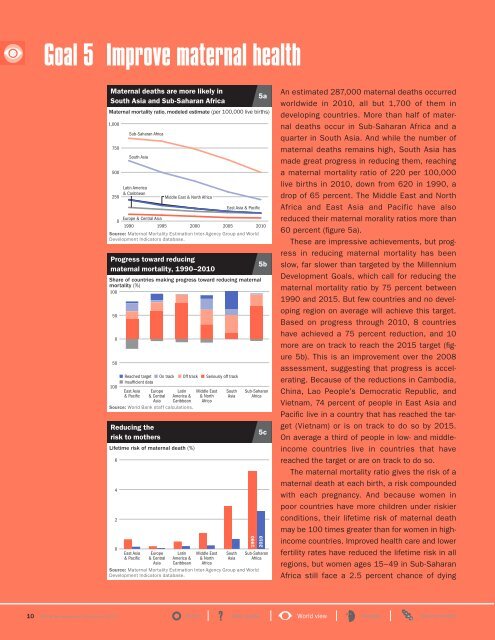World Development Indicators 2013 - Open Knowledge Repository ...
World Development Indicators 2013 - Open Knowledge Repository ...
World Development Indicators 2013 - Open Knowledge Repository ...
Create successful ePaper yourself
Turn your PDF publications into a flip-book with our unique Google optimized e-Paper software.
Goal 5 Improve maternal healthMaternal deaths are more likely in5aSouth Asia and Sub- Saharan AfricaMaternal mortality ratio, modeled estimate (per 100,000 live births)1,000750500250Progress toward reducing5bmaternal mortality, 1990–2010Share of countries making progress toward reducing maternalmortality (%)10050050100Reducing therisk to mothersLifetime risk of maternal death (%)6420Sub-Saharan AfricaSouth AsiaLatin America& CaribbeanEurope & Central Asia01990 1995Reached target On track Off track Seriously off trackInsufficient dataEast Asia& PacificEast Asia& PacificEurope& CentralAsiaEurope& CentralAsiaMiddle East & North AfricaLatinAmerica &CaribbeanSource: <strong>World</strong> Bank staff calculations.LatinAmerica &Caribbean2000Middle East& NorthAfricaMiddle East& NorthAfricaEast Asia & Pacific2005Source: Maternal Mortality Estimation Inter-Agency Group and <strong>World</strong><strong>Development</strong> <strong>Indicators</strong> database.SouthAsiaSouthAsiaSub-SaharanAfrica5c19902010Sub-SaharanAfricaSource: Maternal Mortality Estimation Inter-Agency Group and <strong>World</strong><strong>Development</strong> <strong>Indicators</strong> database.2010An estimated 287,000 maternal deaths occurredworldwide in 2010, all but 1,700 of them indeveloping countries. More than half of maternaldeaths occur in Sub- Saharan Africa and aquarter in South Asia. And while the number ofmaternal deaths remains high, South Asia hasmade great progress in reducing them, reachinga maternal mortality ratio of 220 per 100,000live births in 2010, down from 620 in 1990, adrop of 65 percent. The Middle East and NorthAfrica and East Asia and Pacific have alsoreduced their maternal morality ratios more than60 percent (figure 5a).These are impressive achievements, but progressin reducing maternal mortality has beenslow, far slower than targeted by the Millennium<strong>Development</strong> Goals, which call for reducing thematernal mortality ratio by 75 percent between1990 and 2015. But few countries and no developingregion on average will achieve this target.Based on progress through 2010, 8 countrieshave achieved a 75 percent reduction, and 10more are on track to reach the 2015 target (figure5b). This is an improvement over the 2008assessment, suggesting that progress is accelerating.Because of the reductions in Cambodia,China, Lao People’s Democratic Republic, andVietnam, 74 percent of people in East Asia andPacific live in a country that has reached the target(Vietnam) or is on track to do so by 2015.On average a third of people in low- and middleincomecountries live in countries that havereached the target or are on track to do so.The maternal mortality ratio gives the risk of amaternal death at each birth, a risk compoundedwith each pregnancy. And because women inpoor countries have more children under riskierconditions, their lifetime risk of maternal deathmay be 100 times greater than for women in highincomecountries. Improved health care and lowerfertility rates have reduced the lifetime risk in allregions, but women ages 15–49 in Sub- SaharanAfrica still face a 2.5 percent chance of dying10 <strong>World</strong> <strong>Development</strong> <strong>Indicators</strong> <strong>2013</strong> Front ? User guide <strong>World</strong> view People Environment
















